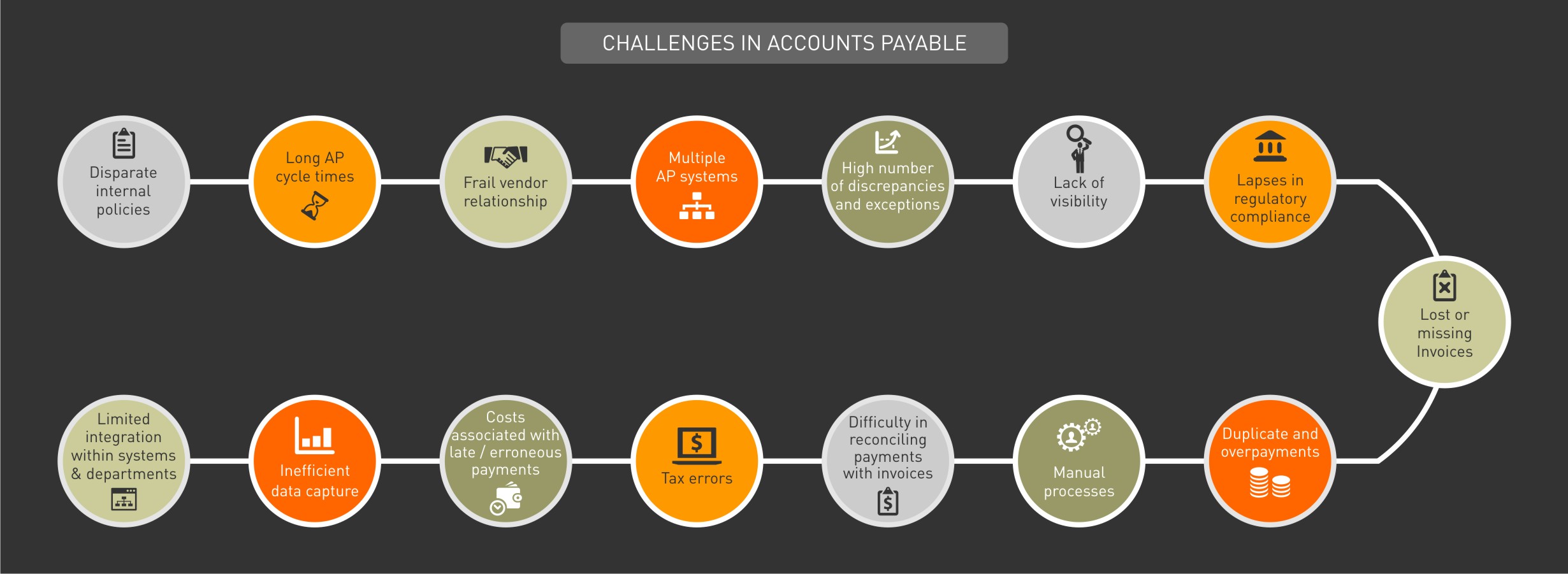Why CFOs Need a Deeper Approach to Spend Management
Spend management is a critical part of the finance function. Chief Financial Officers (CFOs) need to deploy a multi-dimensional approach to make the entire spend management process effective. Analytics can help CFOs dig within each process under spend management and extract insights for incisive decisions.
For instance, the Accounts Payable (AP) process has a multitude of challenges. From multiple systems to manual processes (Figure 1), AP processes today are complex and spread across international borders and time zones.
Figure 1: Challenges in Accounts Payable

Breaking Down the Challenges in Accounts Payable
In most AP systems, the expense data is distorted by internal categorization and account head mapping. The data is often recorded only at invoice total levels and not at line levels. This is not enough for drill-downs and data cubes. To build a data cube, businesses will need line-level details from their vendors’ sales data warehouses. This may start out as a time-consuming and perhaps frustrating process depending on the cooperation of the vendors and the company’s internal data routines. But once the data cube is built, it’s a lot easier to prioritize and tackle line by line orders which can lead to improved productivity.
According to a 2012 study by PayStream Advisors, 64 percent of invoices are still traded via paper. Automation can help save hundreds of thousands of dollars, but that would still be low compared to the value stream of the entire organization. CFOs often think of these as mundane tasks best delegated to accounting or controllership organizations. As long as accuracy is maintained, not much time is spent in considering radical improvements. What is missed is the opportunity that comes from the data embedded deep within the organization and reflected in the AP processes. A typical billion-dollar business may have a million invoices to process a year. These have a wealth of information and insights that escape the best finance and accounting departments.
Most CFOs cannot answer questions such as:
- How many of our invoices are paid on time? Which processes within the organization are causing the most delay in invoice processing?
- How closely integrated is our AP with our sourcing function while maintaining the ‘maker-checker’ layer of controls? Do we measure this integration?
- How much time are my teams spending in processing low-dollar value AP transactions when they could be doing so much more?
- What percentage of invoices and buy is correctly processed for withholding taxes in cross-border transactions?
- How often do we see ‘exceptions’ in the AP process?
From Insights to Action: Strategic Sourcing and Risk Reduction
While a targeted analysis of payment timelines can help improve the cash flow and avoid late fee payments, another area that needs constant monitoring and improvement is sourcing. A thorough analysis of the procurement process is a prerequisite for strategic sourcing. The key points of an effective sourcing strategy that CFOs can focus on by conducting core sourcing analysis are listed below.
- A 360-degree analysis of the buy
- Constant reviews of peers and benchmarks
- Seasonal variations
- Achieving savings’ targets
- Analyzing the tail-end suppliers
- Analyzing the risk exposure on small-value suppliers
- Removal of duplicate vendor accounts
- Increase in cost due to inefficient forex hedging
- Buy processes under exceptions and urgencies
This gives CFOs a bird’s-eye view of the risks and costs involved with sourcing, enabling them to implement the necessary changes.
Multiple departments across the globe have to participate in pushing an invoice through the value stream. If a business can cut down 60 percent of that workflow through clever analytics, not only would the business save time across departments, it would reduce audit risks, decrease finance oversight costs, bring down document retention costs and efforts, and improve downstream visibility. These costs are often missed in conventional cost per invoice analysis and they can be quite high. Analytics can help CFOs to focus on the cost of detection and rectification of errors which, in turn, can lead to a reduced cost of processing. Similarly, analytics can highlight the areas where duplicate payments are made.
And finally, under tax and compliance, analytics can play a significant role for CFOs. A single error can cost a company time, and millions of dollars in litigation and penalties. By infusing analytics in the AP process, CFOs can avoid exposing their companies to expensive lawsuits and a tainted reputation.
AP is just one functional area within finance. There are other specific areas where analytics can play a key role and have a major impact on the overall business. We will be looking at these areas in our forthcoming blogs.